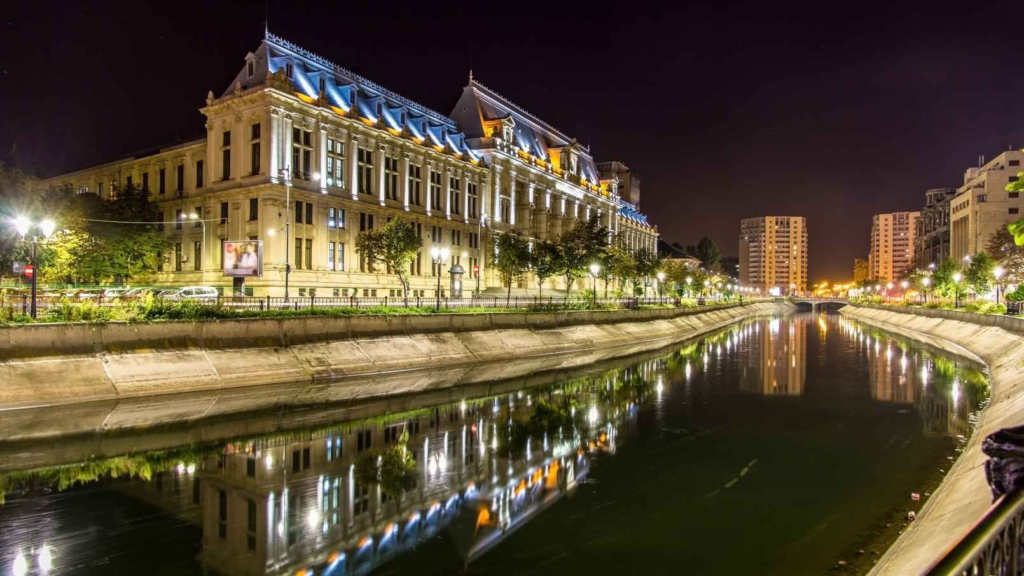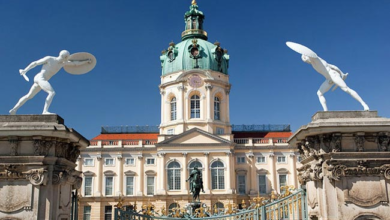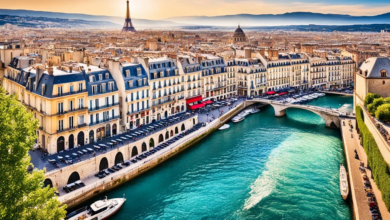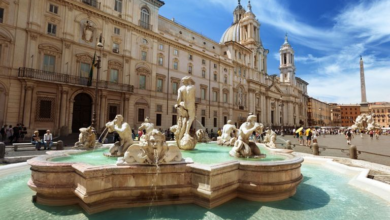The most important tourist attractions in Romania

Romania is a country with many beautiful and unique tourist attractions. Here are some of the most important tourist attractions in Romania:
Certainly, here is some general information about Romania:
Romania is a country located in southeastern Europe, bordered by Hungary to the northwest, Serbia to the southwest, Bulgaria to the south, Ukraine to the north, and Moldova to the northeast. Its capital and largest city is Bucharest.
Romania has a rich cultural and historical heritage, with influences from the Romans, the Byzantine Empire, the Ottoman Empire, and more. It is home to many UNESCO World Heritage sites, including the painted monasteries of Bucovina, the fortified churches of Transylvania, and the ancient Dacian fortresses of the Orastie Mountains.
The official language of Romania is Romanian, which is a Romance language that evolved from Latin. The country has a diverse population, with ethnic Romanians making up the majority, followed by Hungarians, Roma, and Germans.
Romania has a varied landscape, including the Carpathian Mountains, the Danube Delta, and the Black Sea coast. There are many opportunities for outdoor activities such as hiking, skiing, and water sports.
The economy of Romania has undergone significant transformation since the fall of communism in 1989. Today, Romania is a member of the European Union and has a diverse economy that includes agriculture, industry, and services.
Romanian cuisine is influenced by its neighboring countries, with influences from Turkish, Hungarian, and Balkan cuisine. Some traditional Romanian dishes include sarmale (stuffed cabbage rolls), mici (grilled minced meat rolls), and ciorba (a sour soup).
Overall, Romania has a lot to offer visitors, from its beautiful landscapes to its rich cultural heritage and delicious cuisine.
- Bran Castle: Located in the Transylvania region, Bran Castle is one of Romania’s most famous landmarks. It is also known as “Dracula’s Castle” as it is believed to have inspired Bram Stoker’s famous novel.
- The Painted Monasteries of Bucovina: The Painted Monasteries of Bucovina are a group of eight Eastern Orthodox monasteries that are decorated with colorful frescoes and are UNESCO World Heritage sites.
- The Palace of the Parliament: The Palace of the Parliament is the second-largest administrative building in the world, located in Bucharest. It was built during the communist era and is now open to the public for tours.
- The Merry Cemetery: The Merry Cemetery is located in the northern region of Maramureș and is known for its brightly colored tombstones that are decorated with humorous epitaphs.
- The Danube Delta: The Danube Delta is a UNESCO World Heritage site and the second-largest river delta in Europe. It is a unique ecosystem that is home to over 300 species of birds and many other animals.
- The Transfagarasan Highway: The Transfagarasan Highway is a winding road that crosses the Carpathian Mountains and offers stunning scenery. It is open from July to October.
- Peles Castle: Peles Castle is located in the Carpathian Mountains and is known for its stunning architecture and beautiful gardens. It was built in the late 19th century and was the summer residence of the Romanian royal family.
- Sighisoara Citadel: Sighisoara Citadel is a medieval fortified city located in Transylvania. It is the birthplace of Vlad the Impaler, the inspiration for Bram Stoker’s Dracula.
- The Black Sea Coast: The Black Sea Coast is a popular summer destination in Romania, offering beautiful beaches and resort towns.
- The Turda Salt Mine: The Turda Salt Mine is a unique underground attraction located in Transylvania. It is a former salt mine that has been converted into an underground amusement park with a Ferris wheel, mini-golf, and a lake.
These are just a few of the many tourist attractions in Romania. Whether you’re interested in history, nature, or culture, Romania has something to offer.

- Corvin Castle: Corvin Castle, also known as Hunyadi Castle, is located in Hunedoara and is one of the largest castles in Europe. It is famous for its Gothic architecture and its association with the legendary Vlad the Impaler.
- The Transalpina Road: The Transalpina Road is the highest road in Romania, located in the Carpathian Mountains. It offers stunning views of the mountains and is a popular destination for motorcyclists and hikers.
- The Bigar Waterfall: The Bigar Waterfall is located in the Anina Mountains and is known for its unique shape and the way the water falls in thin streams over the mossy rocks.
- The Dacian Fortresses of the Orastie Mountains: The Dacian Fortresses of the Orastie Mountains are a group of six fortresses that were built by the Dacians in the 1st century BC. They are a UNESCO World Heritage site.
- The Bears’ Cave: The Bears’ Cave is located in the Apuseni Mountains and is known for its impressive stalactites and stalagmites. It is also home to the remains of prehistoric animals, including cave bears.
- The Transylvania Train: The Transylvania Train is a vintage steam train that travels through the Carpathian Mountains. It offers a unique way to experience the beautiful scenery of Romania.
- The Palace of Culture: The Palace of Culture is located in Iasi and is one of the city’s most iconic landmarks. It is a beautiful neoclassical building that houses several museums and galleries.
- The Salt Mines of Turda: The Salt Mines of Turda are a popular tourist attraction located in Turda. They are a former salt mine that has been converted into an underground amusement park with a Ferris wheel, mini-golf, and a lake.
- The Apuseni Mountains: The Apuseni Mountains are a mountain range located in western Romania. They offer beautiful scenery, hiking trails, and caves to explore.
- The Danube Gorge: The Danube Gorge is a natural wonder located on the border between Romania and Serbia. It is a narrow gorge that was carved by the Danube River and offers stunning views of the surrounding cliffs.
These are just some of the many tourist attractions in Romania. Whether you’re interested in history, nature, or adventure, Romania has something to offer.
- The Transylvanian Alps: The Transylvanian Alps are a subrange of the Carpathian Mountains and are known for their beautiful scenery, hiking trails, and winter sports.
- The Voronet Monastery: The Voronet Monastery is located in the northern region of Bucovina and is known for its blue frescoes that depict scenes from the Bible.
- The Merry Cemetery of Sapanta: The Merry Cemetery of Sapanta is a unique cemetery located in northern Romania. Its tombstones are decorated with colorful folk art and humorous epitaphs.
- The Apuseni Natural Park: The Apuseni Natural Park is located in western Romania and is known for its beautiful natural scenery, caves, and hiking trails.
- The Biertan Fortified Church: The Biertan Fortified Church is a UNESCO World Heritage site located in Transylvania. It is a beautiful example of medieval architecture and is known for its unique locking mechanism.
- The Sinaia Monastery: The Sinaia Monastery is located in the Carpathian Mountains and is a beautiful example of Byzantine architecture. It is also home to the Sinaia Royal Castle.
- The Iron Gates National Park: The Iron Gates National Park is located on the border between Romania and Serbia and is known for its beautiful scenery and wildlife, including brown bears and wolves.
- The Palace of the Braila Museum of Ethnography: The Palace of the Braila Museum of Ethnography is located in the city of Braila and is a beautiful example of neoclassical architecture. It houses a collection of artifacts that showcase the traditional culture of the region.
- The Apuseni Adventure Park: The Apuseni Adventure Park is located in the Apuseni Mountains and is a popular destination for adventure sports, including zip-lining and rock climbing.
- The Peles National Museum: The Peles National Museum is located in the Carpathian Mountains and is a beautiful example of neo-Renaissance architecture. It was the summer residence of the Romanian royal family and now houses a collection of art and artifacts.
These are just a few more examples of the many tourist attractions in Romania. Whether you’re interested in history, nature, or adventure, Romania has something to offer.
- The Turda Gorge: The Turda Gorge is a natural reserve located in the Apuseni Mountains. It is known for its beautiful scenery and hiking trails.
- The Museum of the Romanian Peasant: The Museum of the Romanian Peasant is located in Bucharest and is dedicated to preserving and showcasing the traditional way of life of Romanian peasants.
- The Bicaz Gorge: The Bicaz Gorge is a natural reserve located in the Eastern Carpathians. It is known for its stunning scenery and hiking trails.
- The Transfagarasanul Infernal: The Transfagarasanul Infernal is a road that crosses the Fagaras Mountains in Transylvania. It is known for its stunning views and hairpin turns.
- The National Museum of Art of Romania: The National Museum of Art of Romania is located in Bucharest and is home to a large collection of Romanian and European art.
- The Cetatuia Monastery: The Cetatuia Monastery is located in Cluj-Napoca and is a beautiful example of medieval architecture.
- The Cistercian Abbey of Carta: The Cistercian Abbey of Carta is located in the Transylvania region and is a beautiful example of Gothic architecture.
- The Cheile Nerei-Beusnita National Park: The Cheile Nerei-Beusnita National Park is located in the Banat region and is known for its beautiful landscapes, hiking trails, and waterfalls.
- The Sarmizegetusa Regia: The Sarmizegetusa Regia is an ancient Dacian fortress located in the Orastie Mountains. It is a UNESCO World Heritage site.
- The Transylvanian Village Museum: The Transylvanian Village Museum is located in Cluj-Napoca and is an open-air museum that showcases the traditional architecture and way of life of Transylvanian villages.
These are just a few more examples of the many tourist attractions in Romania. Whether you’re interested in history, nature, o

- Romania is the largest country in southeastern Europe and the ninth largest country in the European Union by area.
- The Danube River, which forms part of Romania’s southern border, is the second longest river in Europe after the Volga.
- The Palace of the Parliament in Bucharest is the second largest administrative building in the world after the Pentagon.
- Romania is home to over 12,000 caves, many of which are open to visitors.
- The traditional costume worn by Romanian women, known as the “ie,” is a symbol of national identity and is recognized as an intangible cultural heritage by UNESCO.
- Romania is one of the few countries in the world that still has virgin forests, which are home to rare and endangered species of plants and animals.
- The Romanian language uses the Latin alphabet, but has some unique letters and diacritical marks.
- Romania is known for its wine production, with vineyards located throughout the country.
- The Romanian film industry has produced several acclaimed films, including “4 Months, 3 Weeks and 2 Days,” which won the Palme d’Or at the Cannes Film Festival in 2007.
- Romania is home to several world-renowned musicians, including the composer George Enescu and the pianist Radu Lupu.
These are just a few more interesting facts about Romania. The country has a rich and diverse culture, history, and natural beauty that make it a fascinating destination for visitors.
Sure, here are some more interesting facts about Romania:
- The Merry Cemetery in the village of Sapanta is a unique tourist attraction, where the graves are decorated with colorful paintings and humorous epitaphs that describe the life of the deceased.
- Romania is home to the largest population of brown bears in Europe, with an estimated 6,000 bears living in the Carpathian Mountains.
- The Transfagarasan Highway, which crosses the Fagaras Mountains in Transylvania, is considered one of the most beautiful and scenic roads in the world.
- The city of Brasov in Transylvania is home to the Black Church, the largest Gothic church in Romania and one of the largest in Europe.
- The painted monasteries of Bucovina, which are UNESCO World Heritage sites, are known for their colorful frescoes that depict scenes from the Bible and the lives of the saints.
- The Peles Castle in Sinaia is a beautiful example of neo-Renaissance architecture and was the summer residence of the Romanian royal family.
- The traditional Romanian folk dance, known as the hora, is a circular dance performed by people holding hands and moving in a synchronized manner.
- The Carpathian Mountains are home to several ski resorts, including Poiana Brasov, Sinaia, and Predeal.
- The Dacian fortress of Sarmizegetusa Regia, located in the Orastie Mountains, is a UNESCO World Heritage site and was the capital of the ancient Dacian kingdom.
- The city of Cluj-Napoca is home to the largest botanical garden in southeastern Europe, which houses over 10,000 species of plants.
These are just a few more interesting facts about Romania. The country has a rich history, culture, and natural beauty that make it a fascinating destination for visitors.
- The city of Sighisoara is the birthplace of Vlad the Impaler, the inspiration for the fictional character of Dracula.
- The Danube Delta, located in southeastern Romania, is the second largest river delta in Europe and is home to over 300 species of birds.
- The Romanian Athenaeum in Bucharest is a beautiful concert hall that is home to the George Enescu Philharmonic Orchestra.
- The traditional Romanian painted eggs, known as “pysanky,” are a popular folk art that dates back to ancient times.
- The city of Timisoara was the first European city to have electric street lighting, which was installed in 1884.
- The Apuseni Mountains in western Romania are known for their extensive cave system, which includes the Scarisoara Cave, the second largest underground glacier in Europe.
- The Romanian Orthodox Church is the dominant religion in the country, with over 80% of the population identifying as Orthodox Christians.
- The city of Constanta, located on the Black Sea coast, is Romania’s largest port and a popular tourist destination.
- The painted pottery of Horezu, a traditional craft from the village of Horezu in southern Romania, is recognized as an intangible cultural heritage by UNESCO.
- The city of Alba Iulia is home to the Alba Carolina Citadel, an impressive fortress that was built in the 18th century and is considered one of the most important Vauban fortresses in Europe.
These are just a few more interesting facts about Romania. The country has a rich cultural heritage, beautiful landscapes, and a fascinating history that make it a unique and exciting destination for visitors.
- The Palace of Culture in Iasi, built at the beginning of the 20th century, is a beautiful example of neoclassical architecture and is home to several museums and galleries.
- The Merry Cemetery in the village of Sapanta is a unique and colorful tourist attraction where the graves are decorated with paintings and humorous epitaphs that describe the life of the deceased.
- The city of Cluj-Napoca is home to the largest botanical garden in southeastern Europe, which houses over 10,000 species of plants.
- The traditional Romanian blouse, known as the “ie,” is recognized as an intangible cultural heritage by UNESCO.
- The Romanian currency is the leu, which means “lion” in Romanian.
- The city of Sibiu, located in the Transylvania region, was named the European Capital of Culture in 2007.
- The painted monasteries of Bucovina, which are UNESCO World Heritage sites, are known for their colorful frescoes that depict scenes from the Bible and the lives of the saints.
- The Romanian film industry has produced several acclaimed films, including “4 Months, 3 Weeks and 2 Days,” which won the Palme d’Or at the Cannes Film Festival in 2007.
- The traditional Romanian folk dance, known as the hora, is a circular dance performed by people holding hands and moving in a synchronized manner.
- The Danube Delta Biosphere Reserve, located in southeastern Romania, is home to over 5,000 species of plants and animals and is recognized as a UNESCO World Heritage site.
These are just a few more interesting facts about Romania. The country has a rich cultural heritage, beautiful landscapes, and a fascinating history that make it a unique and exciting destination for visitors.



